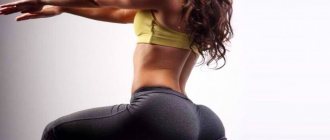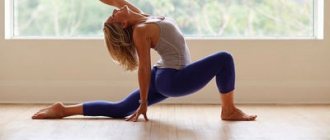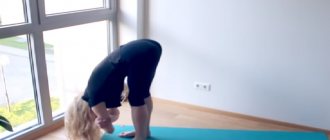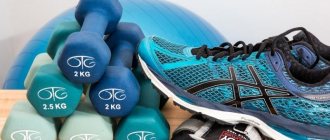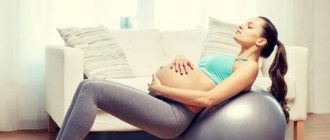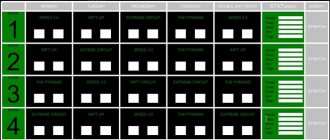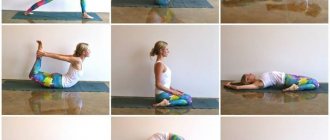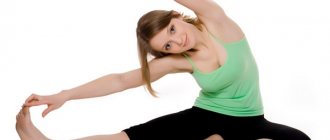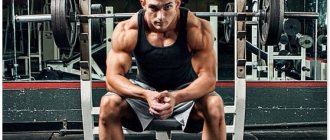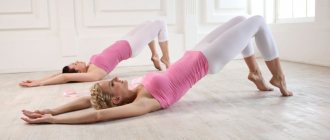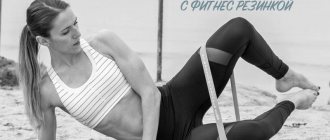Where does the neck begin? From the picture in your MRI?
Mikhail Baranov
Usually ordinary yoga practitioners, like most people, begin to become seriously interested in the structure of the spine only in one case - after visiting a radiologist's office. Looking at photographs of their cervicothoracic region and perplexedly feeling their neck from different sides, they, as a rule, hear a lot of new, strange and frightening expressions: protrusion, spondylosis, osteochondrosis... Moreover, they themselves soon begin to scare mom, dad and friends and comrades. To avoid being intimidated by a hedgehog in such a situation, you need to take simple measures.
The spine is usually divided into five sections. The most mobile ones—the cervical and lumbar—are the first to wear out and age. It is well known that the neck and lower back, as the most mobile parts of the spine, are most at risk of injury. The cause of injury in asanas is not only the excessive zeal of beginning hatha yogis in backbends with support on the chin and head or carelessness in the technique of performing inverted poses. Even among “experienced” people who have been practicing for several years, similar problems “happen”. Without going into superficial arguments that they probably practiced incorrectly, the instructor was bad and the weather was cloudy, and without dwelling on such reasons as age-related changes, constitution, unhealthy diet, sedentary lifestyle, depression, menopause, chronic alcoholism, hobby boxing and the like, let's look at a few simple exercises that can not only prevent neck injuries, but also rehabilitate after injuries.
Bypassing the eternal question of the Russian intelligentsia, “Who is to blame?”, Let us immediately move on to the question “What to do?”
Are there any restrictions
Severe lesions of cartilage tissue, large herniated intervertebral discs, and extensive cerebral circulatory disorders do not allow the practice of yoga. Exercise in such cases can only aggravate the course of the disease and provoke its complications.
Contraindications for performing asanas:
- acute mental disorders;
- heart defects, recent heart attack;
- hematological diseases;
- injuries of the skull and brain tissue;
- malignant neoplasms;
- arterial hypertension;
- postoperative period;
- diseases of the gastrointestinal tract;
- intoxication of the body, accompanied by an increase in temperature.
It is allowed to practice yoga only if there are no serious complaints or illnesses in the acute stage. Each asana is not only a gymnastic exercise, but also a unique way to treat diseases of the musculoskeletal system.
Neck warm-up. Performed standing or sitting in Virasana.
Any activity should begin with gentle warm-up movements, especially if you are exercising in a cold room or have come from cold air. Dynamic work with the neck (vyayama) begins with longitudinal traction of the cervical spine, which must be maintained during movement. That's why the first exercise is called "Baron Munchausen pulls himself out of the swamp with a horse sandwiched between his legs." While maintaining a vertical position of the neck, gently but persistently pull the head up by the hair on the top of the head and lower the shoulders down.
Next, maintaining the achieved feeling of extension, we proceed to the cycle of exercises “A sleepy horse raises and lowers its head, shaking off the duckweed stuck to its muzzle, turns its head in different directions in bewilderment and, in a state of extreme amazement, performs completely strange movements with its head.” We start by tilting forward and backward, then turning the head left and right (the chin should move in the same horizontal plane), then bending to the side, and ending with head rotations.
While performing all these movements, it is very important to maintain the feeling of neck extension (you can “remind” yourself of this feeling by repeating the first exercise a couple of times between the “horse” exercises). For example, when tilting your head back, we do not press the back of your head to your back, but stretch your face up; when performing turns, we pull the top of your head up, tilting your head to the side - we try not to touch your shoulder with your ear, but stretch your neck with your upper ear up, while simultaneously lowering your shoulders down.
Two types of rotations are used: the first - we “draw” circles with the top of the head, gradually increasing their radius according to sensations. The second is to “draw” circles with the chin, that is, we make movements with the head in the vertical plane (the chin stretches “up-forward-down-toward” and vice versa). When performing rotations, an unlimited amplitude of movement is first selected, which gradually increases if there are no unpleasant sensations.
For therapeutic purposes, these exercises are always done 1-2 times a day, very slowly and consciously, with a painless amplitude and with a gradual increase in the number of repetitions (you can start with ten and add, say, one per day or 10 per week, until get bored, or rather, until you feel like this is the optimal amount for your neck).
We finish the warm-up with a short strength fixation.
The head is vertical, we place the palms intertwined in the fingers on the forehead, inhale smoothly and deeply, as we exhale we begin to press the head on the palms, and with the palms on the head, maintaining a vertical position of the cervical region. At the end of exhalation, maximum effort is applied - but this is only for healthy people(!). For those who already have problems with the neck - old injuries, osteochondrosis, spondylosis, etc., a softer version is recommended, but with a large number of repetitions and 2 times a day.
The exercise is performed in a similar way with palms on the back of the head, and then with the right and left sides - in this case, one palm is placed on the ear, the neck remains vertical. To reduce the load, in the therapeutic version, applying pressure on the head with two or three fingers is enough. The time of isometric load on the neck muscles is determined individually. To begin with, 5-10 seconds with moderate effort are enough, you can gradually increase the pressure and time of the exercise - up to 15-20 seconds, this is quite enough to obtain a characteristic strengthening effect.
Stretching the muscles of the collar zone.
The following exercise stretches the sides of the neck well and relieves tension at the base of the neck. It gives the most complete effect if performed after the short static fixation mentioned above. In a sitting position: the left hand “grabs” the right ear over the head, the right hand grabs the ankle (thus fixing the body), as you inhale, the neck stretches upward, as you exhale, the body tilts to the side, so that the feeling of extension moves to the base of the neck. Fix 3-4 breaths, then repeat on the other side.
Typical mistakes:
- Hand pressure on the head.
- Tilt the head forward or throw it back - when performed correctly in the first phase of the exercise, the neck should be strictly vertical, the movement occurs in one plane.
- Stretching the neck to the side rather than up (diagonally) - this can occur if the body is not tilted to the side, while the opposite shoulder is raised. As a result, the spinal discs become more compressed instead of stretched; in addition, the muscles of the collar zone are less stretched in this case. It is important to create a preliminary upward stretch, and then, holding the ankle with your lower hand, pull your shoulder down from your neck, moving your head up and then to the side.
- A sharp stretch, which leads to muscle contraction, exacerbating the so-called “posture reflex,” which is expressed in the fact that the muscles contract when trying to sharply stretch them. Therefore, it is necessary to “flow” into the asana gradually, gradually increasing the force of traction. The fixation is performed for at least 20 seconds, because only after 10–15 seconds the tense muscles “give up” and begin to truly relax and stretch.
A similar extension is performed on the back of the neck, with the fingers intertwined behind the head and the thumbs placed at the base of the skull behind the ears.
After which it would be optimal to move on to working on the thoracic spine, since for most people it is magically connected to the cervical spine.
Cat-cow
Marjariasana will help relieve neck pain. Other names: “cat-cow”, “stretching cat”. Get on all fours, bring your knees together. Start in cow position: inhale while arching your back. Tilt your head and stretch your neck upward.
Next, move into cat pose (stretching cat). As you exhale, press your chin to your chest and arch your back to form a hump. The arms and legs do not work. Perform the exercise for 10 breathing cycles. Longer execution (1-2 minutes) will give better results.
Exercises for the thoracic region
("The horse tries to shake off Munchausen")
The first rotation of the shoulders - the arms are relaxed, the shoulders rise as high as possible to the ears and are pulled back, the shoulder blades come together, the shoulders drop down and move forward; rotation is performed first in one direction, then in the other direction.
The second rotation of the shoulders differs from the first only in that the shoulders move alternately, which is accompanied by involuntary small turns of the body and soft twists in the thoracic region.
The third shoulder rotation is performed with arms extended to the sides (see picture below). In this case, alternating tension and stretching of the muscles of the back and front surface of the body occurs. As you inhale, the head turns, the arms move to the sides and back, the face and chest stretch upward (in this case, the neck stretches). The shoulder blades come together, the back muscles are tense, the chest is expanded as much as possible. As you exhale, the chin stretches down, the shoulder joints twist inward, at the end of the movement, the arms turn as much as possible with the palms up, tense and stretch to the sides.
Important:
Do not pinch, but stretch the back of the neck; while inhaling, expand the chest;
at the end of the exhalation, twisting, strain your arms as much as possible - just like squeezing out wet laundry.
Shoulder rotations, if desired, can be performed not after the exercises from the series “A sleepy horse turns its head...”, but between them, one at a time - rotate the head, rotate the shoulders, etc.
Half King of Pisces Pose
Another popular yoga pose for the neck is Ardha Matsyendrasana. Translated from Sanskrit – Half Pose of the King of Pisces. This unique asana heals the spine and normalizes blood circulation. Sit on the floor with your back straight. Bend your right leg and place it on your left: its foot should be at the beginning of the left thigh.
Grasp your right leg with your bent left arm, placing your right palm on the floor. The body must be strictly vertical. Then begin twisting your torso to the right along with your head. Stay in the pose for 3-5 breaths. Then smoothly turn back and repeat the twist on the opposite side.
- Gel nail extensions
- Health insurance - how to apply for a compulsory and voluntary insurance policy, review of companies and cost
- How to buy points for retirement in 2020
Exercises to strengthen neck muscles
The head has weight and it should be used passively without moving the head or affecting the neck with the movement.
The therapeutic version of the exercises described below is performed, if possible, in all four positions: lying on your back, stomach, right side, left side. The fixation time is determined by sensations, or simply by fatigue, which BARELY BEGINS (!) to be felt, but even this option in the acute stage may turn out to be too harsh and dangerous - in this case, for the time being, it is necessary to limit oneself to other exercises - primarily traction , and as you improve, include exercises that increase blood flow. “Averagely healthy” people who do not have significant impairments, but have a weakened muscle corset, can gradually increase the fixation time to one minute, guided by the subjective sensation of tension in the neck muscles. With regular practice of asanas, one option is enough for them - lying on their back. An important criterion for the correct performance of these exercises is the isolated work of the neck muscles - the shoulders, face, hands and other parts of the body that are not needed to hold the head above the floor must be relaxed.
Exercise one: lie on the floor face down. Place your forehead on your hands. Lift your forehead from your hands so that your head hangs in the air strictly face down. Remove your hands so that the tip of your nose almost touches the floor. And keep it. After some time, when the neck muscles begin to get tired, place your hands again and carefully lower your forehead onto them.
Exercise two: lie on your back and raise the back of your head from the floor a couple of centimeters (this distance in most cases is determined by the width of your palm placed under your head), your face looks up. And keep doing this until you feel tired in the neck muscles. There are two important nuances. First, the head should not be thrown back or tilted with the chin down. The neck should be stretched parallel to the floor; in the correct position, a distance between the chin and collarbones is maintained approximately equal to the palm spread across it, but depending on the body type and the presence of spinal curvatures, the height of the head above the floor can be different, the main thing is that the neck is evenly extended. Secondly, your shoulders should not tense up and “help” hold your head above the floor; it is extremely important to learn to relax your shoulders in this position and hold the weight of your head only with your neck muscles.
It is convenient to use exercises lying on your back immediately before savasana, at the end of the asana complex.
Exercise three: lie on your right side, raise your head so that your neck is parallel to the floor, and hold it so that the muscles on the left side of your neck work.
Then the fourth exercise , lying on your left side, similar to the third.
This way we strengthen the neck muscles without moving.
Traction (traction)
Let's start with the fact that in the acute stage, when any movement causes acute pain, only traction therapy is used. In this case, traction exercises should be limited temporarily. In the remission stage, it is necessary to gradually move on to warming up and strengthening exercises, since traction by itself does not solve the problem, and constant traction without subsequent strengthening of the muscles leads to an even greater “looseness” of the spine.
Soft version: in a lying position on your stomach, the palms are placed one above the other, the elbows are directed forward, the chin clings to the palms, due to which traction occurs. The first photo shows the position of the hands, the second shows what the exercise itself looks like.
A tougher option: hanging the head in uttanasana: feet hip-width apart, bending over, grasping the head with the thumbs under the chin, and placing the palms on the back of the head closer to the base of the skull. While bending over, very gently guiding the movement with your hands, we rotate your head and stretch your neck under the weight of your head and arms.
Traction therapy is aimed at increasing the distance between the vertebral bodies. This significantly reduces the load on the vertebral discs and the nucleus pulposus, which is especially important in cases where there is already a protrusion or hernia. By increasing the diameter of the intervertebral foramina, compression and swelling of the nerve roots, which occurs with “neck problems,” is eliminated.
What explains these “problems”? The weakening of some muscle groups leads to chronic hypertonicity (spasm) of other muscle groups, due to which the blood flow to the vertebral body is disrupted, microcirculation slows down and the nucleus pulposus (which retains its shape by absorbing fluids from the surrounding tissues) loses its qualities and protrudes into the intervertebral the space and height between the vertebral bodies decreases, thus reducing the diameter of the intervertebral foramina and pinching the nerve roots, which in turn swell. Compression and swelling of the nerve roots leads to disruption of the conduction of nerve impulses, which can result in partial numbness of the limbs and, in the worst case, leads to unilateral paralysis.
Recommendations for Beginners
Before you begin yoga therapy for the neck, it is important to learn the necessary rules for beginners, which will help you prevent common mistakes and get positive treatment results after just a few sessions. They are as follows:
- All movements are performed smoothly and slowly. Haste, lack of concentration and yoga are incompatible concepts. Separately, it should be noted that movements made daily should also be smooth.
- It is important to monitor your breathing. Activation of regenerative processes can only be achieved if the rules of breathing practices are followed. You should alternate between deep breaths, exhalations and shallow breathing. Instructions from a competent trainer will help you learn more about the basic principles of yoga breathing practices, which will also help strengthen your neck.
- It is necessary to make adjustments to the diet. A balanced diet, saturating the body with important microelements and vitamins will help increase the effectiveness of the exercises performed.
Before starting a yoga session, it is recommended to do a light warm-up for the neck, which will prevent excessive stress on muscle tissue and activate metabolic processes. The warm-up complex includes neck turns, head tilts, raising arms and shoulders.
General therapeutic effect of exercise.
Dynamic part:
- blood circulation and microcirculation improves;
- increased blood flow helps strengthen the walls of blood vessels and improve the quality of connective tissues;
- the nucleus pulposus restores its shape by absorbing fluids from the surrounding tissues, in which blood flow is increased (which, in fact, is what the effect of “retracting” the hernia is based on).
Statics:
- isometric exercises strengthen the muscular corset, stabilizing the spine (loss of stability of the ligamentous apparatus leads to displacement of the spinal discs, pathological muscle spasm and partial pinching of both nerve roots and cervical arteries, resulting in deterioration of blood flow to the brain, headaches, and decreased ability to work , weather dependence appears - increased sensitivity to changes in atmospheric pressure).
- force, then traction (post-isometric relaxation): normalizes muscle tone, eliminating chronic tension (spasm) and thus improving blood circulation.
Traction (passive traction):
- increases the distance between the vertebral bodies;
- eliminates compression and swelling of nerve roots and arteries.
In case of protrusions and hernias, it is important to use orthopedic devices in your bedchamber - a mattress and a pillow, so that you can rest peacefully. Being in a horizontal position for quite a long time, which is ensured by the correct pillow, the neck naturally stretches - this is several hours of traction a day. When performing savasana, it is also recommended to use an orthopedic pillow or place something under the neck and head to make it comfortable.
As an addition to this topic, I would like to give several examples of similar loads on the cervical spine in a number of asanas. The first group contains asanas that are beneficial for the neck when performed correctly; if performed incorrectly, they are relatively harmless. The second group contains asanas that, if performed incorrectly, lead to disastrous results, and if there are problems with the cervical spine, they are either completely contraindicated or are used in a highly modified version.
